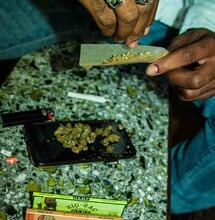Ed Rosenthal - The Book Harvest And Top Tips

During his trip to Amsterdam, Soft Secrets sat down with the chief himself, Ed Rosenthal to ask about his latest book Harvest, as well as what top tips he has for our readers. SSUK: Hi Ed, You have a new book out Harvest, congratulations. Can you explain how this book came about?
My book The Marijuana Grower’s Handbook is rather complete, and it does cover harvesting. I felt there was so much more information that could be covered in it, that would help people to produce a better crop, weather they were using it for flowers or for concentrates. I felt this information should be preserved to decided to write a book about it. [caption id="attachment_8518" align="alignnone" width="800"] Ed Rosenthal[/caption] What amount of research went into creating the book? I had already done a lot of research in harvesting, also doing other works and watching harvests. Also by reading, both about harvesting of marijuana and other crops. I did a series of experiments, many of which are outlined and discussed in the book.
Then I developed new techniques for some aspects of the harvest through curing. I demystified some of it; this was all by research, I found the claims that some manufacturers had wasn’t true, and some claims were. It is thorough testing of new techniques of manicuring, so I think I did perhaps six months of research first, then 53 weeks to write the book. In your book you explain some tools that can be used. Can you tell more? The tools are specifically made for manicuring cannabis for instance. There are a lot of commercial tools that we have tested. We discuss the different tools, and then the other thing is, I have developed new techniques for harvesting, and all of that is outlined in the book.
How will the book Harvest benefit growers? It will save them time, labour, money, and disappointment in their crops. That is how it will do it. [caption id="attachment_8519" align="alignnone" width="800"] Harvest, Ed Rosenthal’s newest book[/caption] Where can our readers find a copy of Harvest? It is available in the United States, Amazon and it can be bought as an E-book. Hopefully, it will be out soon in German. Then it will become available in Europe in German.
What are your tips for when using organics? Don’t bite off more than you can chew. I am not saying you should not dream, or am I suggesting that the person or organisation that is growing should not expand their grow. What I am talking about is don’t bite off more than you can chew, in the sense that it is more important to produce a highly successful, quality, harvest than it is to produce a lot of flunk weed. You are more likely to get a great harvest if you stay within the limits of your ability and resources. That may be based on capital or your labour.
What are your top tips for insects and pests? It depends on whether you are indoors or outdoors. Usually you rarely have to take care of the plants in terms of insects or pests outdoors, however, sometimes aphids, mites or other insects can get the better of the plants. For instance, if a moth or a butterfly, especially a butterfly lays its eggs on the plant or a cabbage moth, then you are likely to have a lot of caterpillars.
The first thing to do with caterpillars is literally shaking them off the plant, on to a piece of paper or card. Then the second thing is there are a lot of biologicals that can be used, to get rid of the insects. [caption id="attachment_8520" align="alignnone" width="800"] Ed’s Marijuana Growers Handbook is already a classic[/caption] Pests are more likely to occur indoors, so the best way to deal with them is by not letting them in. If you should see any infection, then it is very important to take care of it extremely quickly. More often than not it is better to remove the infected plant or clean out the infected section, then to take preventative matters around that section. Some of the things that you can do are to use a bacterial spray, which is a spray that has bacteria that goes after the pest. You can also use a totally organic pesticide. Some areas of the United States and in some parts of Canada, you cannot spray the plants at all. Really the best solution is to prevent the insects from getting in.
What are your top tips for the vegging stage? If you are not dealing with a plant count, you can grow plants very close together, so they virtually do not need a veg stage. Perhaps a week or so from a clone, or a month from seed germination, and then have them grow very closely together. For instance 36 plants per metre, so they are so close together that as soon as the canopy is covered with greenery, so looking down you would only see very little of the undercover. Then you want to put them into flowering, and that is a much faster way to do veg, than spending a lot of time growing one big plant and then flowering it. By growing a lot of plants, each plant only needs to grow for a little bit and for the most part, avoid vegging.
What are your top tips for the flowering stage? The main thing about flowering, is that you want to keep the room relatively dry. That helps to prevent mould; also I would not put much of a temperature difference between the light and dark periods. Perhaps a difference of 3-4 degrees Celsius lower. That will prevent a lot of disease, powdery mildew, and brown mould by keeping the humidity low.
What are your top tips on using Carbon Dioxide? Use it from germination until the plants have finished flowering. The thing is if you don't use it and grow indoors, then you are wasting electricity. Carbon Dioxide is much cheaper to bring into a grow space than electricity is. By not using Co2, you are not getting the full potential from the electricity. Co2 is a major factor, bringing the ppm to 1200-1300 in an indoor area and outdoors it can also be used.
What are your top tips for better understanding terpenes? There are several ways that aging affects terpenes. One way is that the terpenes actually evolve, or change with age. Terpenes may affect each other in one way or another so that as they age, they will either combine or have an association with one another. The third way is the terpenes evaporate and when they do, terpenes that were always there that you did not detect become more obvious. An example that is similar to terpenes is chlorophyll. Leaves are green because of chlorophyll, but in the fall leaves change colour to different reds, oranges, and yellows. Those pigments were always in the leaves but were hidden by the green, so once the green chlorophyll was gone, those pigments become apparent. The same thing happens with terpenes.
What are your top tips for harvesting and curing? Do not cure in jars. If you really want to know how to do it easily, cheaply, less effort and labour, while having a better time doing it, then get a copy of Harvest.
Thank you Ed for taking the time to enlighten the Soft Secrets readers. Good luck with your future plans and we hope to catch up again, in the near future! Harvest and other books from Ed Rosenthal are available through Amazon and other online stores. By Stoney Tark



